George Saunders and Dick Cavett, Bob Mould, Roberta Smith
I love Dick Cavett so much. Tonight he does the NYPL with George Saunders! Also this terrific panel is happening on the role of size and bombast in the art world. (More here!)
How 'Minority Report' Trapped Us In A World Of Bad Interfaces
by Christian Brown
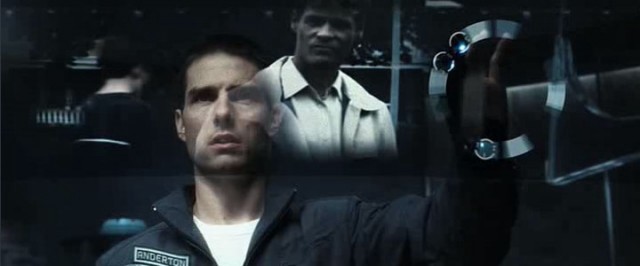
I wish I could get away with charging my clients a fee for every time they say “Minority Report” to me. I’m a commercial artist in L.A., and 90% of commercial art is shutting up and giving the client what they want. That means I spend a lot of time trying to repackage Steven Spielberg’s vision of the future: floating graphical windows with video hovering in them, typography flickering and animating in response to actors’ actions, interfaces appearing and disappearing when fingers reach out to poke them. In short, building a virtual iPad interface, hovering in front of the actor using it. In Spielberg’s future, you only have to twirl your fingers at a computer screen to make it do what you want. It looks cool enough, but it’s time for us to let it go: we’ve built our graphics and our electronics around interface eye candy, rather than trying to come up with new and more effective ways to control our real and imaginary gadgets. The best thing you can say about touchscreens are they look good on camera and they’re better than T9 texting, which is kind of like being better than fax machines.
The next in a short series about our strongest movie opinions,
past and present.
It’s important, of course, to put this in context. Minority Report came out in 2002, and we had touchscreens for a long time before then. If you want to feel really let down by the future, here’s the Prius computerscreen-o-matic as interpreted by a 1987 Buick Riviera. Even multitouch had been played with before the movie came out — just in labs, and very expensively. Minority Report’s cleverness was not in inventing new technology from whole cloth, but in extrapolating existing tech into practical, consumer-friendly products.
In the run-up to production on the movie, Spielberg invited a panel of tech experts and self-identified futurists to an “idea summit.” Their goal was to create a plausible description of the world of 2054 based on what was current, cutting-edge technology, rather than just constructing one from nothing. Self-driving cars, retina-scanning billboards and criminal-identifying spiderbots all made the resulting 80-page “2054 bible,” but the most influential invention of the futurists is the gesture-controlled display.
In the movie, when Tom Cruise straps on his infogloves and starts rummaging through the dreams of the psychic precogs, classical music begins to play. He stands in front of a semicircular computer screen, the size of a wall, and uses his hands to fast forward and rewind, to zoom in and out and rotate the screen. Many of them are laughable — he places one hand in front of another to zoom in, like a vertical hand jive. He goes to shake someone’s hand and all his files are thrown down into the corner. It’s, frankly, absurd — especially if you haven’t seen it since 2002. THIS is the thing tech reviewers are always comparing a new interface to? Even so, there are recognizable gestures that anyone with an iPhone has used. The pinch-zoom, the rotation, and the swipe-to-dismiss are all used daily by smartphone users. And while Cruise’s begloved gesticulation is silly on its face, everyone else in the movie has to use a regular old multitouch computer monitor.
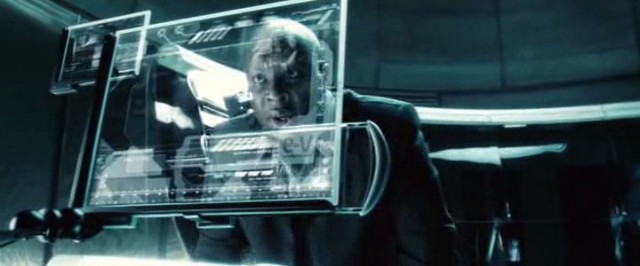
If there’s anyone to blame for the gesture-based interface Cruise uses, it’s virtual reality engineer Jaron Lanier, and the most outspoken member of the think tank, entrepreneur and MIT Media Lab alum John Underkoffler. Lanier, who brought working prototypes of glove-tracking hardware to the idea summit, eventually went on to develop the Kinect gesture-recognition system for the Xbox 360. But it was Underkoffler who took Spielberg’s request for an interface that’s like “conducting an orchestra” and turned it into the gestures we see on screen. In a 2012 interview, Underkoffler said he “devised this whole kind of sign language for interacting with this computer, for controlling the flow of all this information.”
The problem is, that sign language has gotten stuck in our cultural mind, like a particularly virulent earworm. In 2006, a year before the iPhone’s debut, Jeff Han gave a TED Talk about multitouch gestures, demonstrating the use of them to manipulate photos and globes. Throughout, he described gestures as an “interfaceless” technology, a way to intuitively zoom in and out and rotate around images without a “magnifying glass tool.” This is, of course, nonsense. While touching something to get more info may be intuitive, every other gesture demonstrated is noteworthy for how NON-instinctive it is. Does pressing with one hand and dragging with another really intuitively represent rotation? Especially of a 3D object, like a globe?
There are better ways to handle spatial ideas, ways which are more in line with the way our bodies are built. Human hands and fingers are good at feeling texture and detail, and good at gripping things — neither of which touch interfaces take advantage of. The real future of interfaces will take advantage of our natural abilities to tell the difference between textures, to use our hands to do things without looking at them — they’ll involve haptic feedback and interfaces that don’t even exist, so your phone shows you information you might want without you even needing to unlock and interact with it. But these ideas are elegant, understated, and impossible to understand when shown on camera.
The reality is, there’s a huge gap between what looks good on film and what is natural to use. Movie computers are designed to look cinemagenic. Mostly this translates into transparent screens and huge fonts — things nobody would try and put on a phone. But touch-screen interfaces, which look great because of how easy it is to tell what a user is doing on camera, have managed to take over our lives.
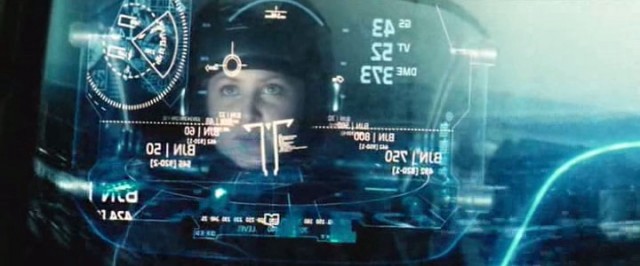
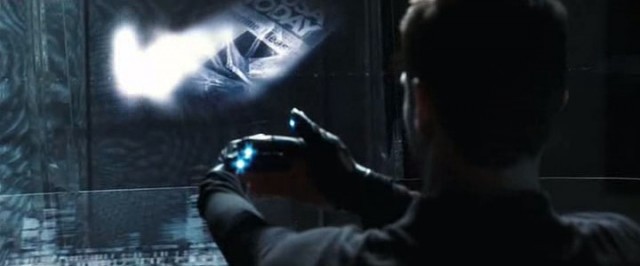
This isn’t to argue that touchscreens are useless. They’re a great way to cheaply interact with a small electronic device — like, say, a phone. But the problem is the outsized role the touchscreen has taken in our pop cultural understanding of computer interfaces. The “hovering multitouch” interfaces of Iron Man 2, Total Recall, and Tron have become pop culture’s vision of what’s state-of-the-art, even outside of Spielberg’s movie. None of these are fundamentally different from Minority Report’s technoscreen — they just have varying distances between fingertip and graphic. But all of them are, essentially, what design critic Bret Victor has called “pictures-under-glass.” They are interfaces that look good, rather than interfaces that work well.
Put another way: If Jeff Han had designed a keyless entry system for a car, it would’ve involved dragging a secret gesture on the car’s window instead of the car automatically unlocking when you open the handle if you have the key in your pocket.
And at the end of the day, it’s visual accessibility driving this trend. Hopefully one day we’ll reach the point where filmmakers don’t want computers to look like conducting an orchestra, and we’ll be able to back out of this interface cul-de-sac and find our way forward into a genuinely natural way of using our devices. Like porn, techno interfaces are more focused on what looks good than what feels good. And like porn, it’s pretty hard to get people to stop buying. Here, I’ll make a deal: If we’re gonna be focusing all our cultural attention on something so impractically sexy, can it be jetpacks instead?
Previously in series: Why We Need Best Supporting-Supporting Actor & Actress Categories
Christian Brown is an animator in Los Angeles.
New York City, February 24, 2013

★★★★ A reprieve. Instead of snow or rain, what came spilling out of the morning clouds was sunshine. The clouds consolidated again, then continued to de- and reconsolidate through the day. A lost cluster of balloons, purple and green, rose straight up all the way past the tower tops before it found enough wind to carry it off. In the park, clouds of gnats flickered by the locked gate to the Sheep Meadow. On the unfenced side of the path, winter had beaten the ground to bare, slick muck, but all that could touch the meadow was the sun, making a lustrous yellow-green velvet of it. Puddles lay here and there on the pathways, none of them amounting to a real obstacle or even much of a lure for the toddler. The clouds closed over again, but no one missed the warmth enough to complain. The children clambered up an outcropping of schist, commandeering the ancient rock with the full authority of the moment.
Can You Construct A Functional Joke About A 9-Year-Old At The Oscars?
I’m glad @theonion apologized for calling Quvenzhané Wallis curt. She’s nine years old, who cares if her answers are short.
— Jesse Berney (@jesseberney) February 25, 2013
So The Onion apologized today for one of their many, many Oscars jokes last night. Which one? The one that was nooooottttt good or okay. Nooo, the other one.
Quentin Tarantino has been heavily criticized for his frequent use of the word “nigger” during tonight’s red carpet interviews #Oscars2013
— The Onion (@TheOnion) February 25, 2013
Yeah, not that one. (That one is actually maybe good satire, about when and how some things are okay.) Buoyed by the success of that joke, I would imagine, and also entering a sweary patch of the evening…
‘Jane Eyre’ is unfortunately not nominated tonight because it didn’t come out this year and was fucking terrible #Oscars2013
— The Onion (@TheOnion) February 25, 2013
…they went for a now-infamous joke about 9-year-old nominee Quvenzhané Wallis. The apology was very straight, and not that great. (“No person should be subjected to such a senseless, humorless comment masquerading as satire.”)
Actually? The apology was kind of terrible and dumb! It’s almost impossible to do any explaining in an apology, but in this case, it seems worth it. “This joke was unsuccessful” is a weird thing to say, but that’s the truth. “This joke didn’t actually succeed in sending-up people’s attitude about famous people” would just create more trouble. The apology read like the business department freaking out, instead of editorial saying, “Hey, we got together and really talked about this.”
And then, you know, is no one going to say that this is a joke about Anne Hathaway??? (Related: “Hey, maybe calling Hathaway a ‘dirty slut whore bitch’ is horribly sexist.”)
Speaking of: here’s how not to deal with this event at all:
And what the Onion missed is that it’s Anne Hathaway who’s the real cunt. Right EVERY WOMAN ON THE INTERNET?
— Jack Moore (@BuzzFeedJack) February 25, 2013
(Uh…)
This particular kind of going afoul happens to lots of us, and by “lots of us” I mean at male-dominated outfits. (In 2002, The Onion had five writers, one woman and four men. Six of the 30 present and former staffers listed on the site’s Wikipedia page are women. When The Onion relocated from New York a few years ago, all the women quit, because they’re too smart to live in Chicago. (That’s a “joke” too.))
Sidebar: there is also a case to be made for not making an apology! This — a fake apology “spoofing” the actual apology, from former employees — is not a good way to make that case.
Anyway.
Well now how do I confirm my meeting with Quvenzhané next Tuesday?
— Richard Lawson (@rilaws) February 25, 2013
In a similar but somewhat more successful vein, The Onion did a “Ha ha this seven-year-old is going to be a prostitute” Honey Boo Boo monologue piece last September:
In the worst-case scenario, my reckless behavior and destructive lifestyle will entangle dozens of people within an inner circle of handlers, publicists and hangers-on with whom I’m still able to surround myself due to appearances at nightclubs and adult magazines, which will pay just enough money to keep me from insolvency — that is, until I reach an age in which the public inevitably tires of me and I have to resort to pornography or prostitution.
They didn’t get outrage, in part because the child in question actually is regularly talked about like this, but also because they had the length to elaborate on the conceit.
Part of me wonders if jokes about the c-word, songs about seeing boobs (in rape scenes!), would sting less with a Kathryn Bigelow Oscar nod.
— sarah sprague (@sarah_sprague) February 25, 2013
Various white male tweeters to world: Can’t everyone just relax and enjoy this tasteless joke about a 9-year-old girl?
— Judd Legum (@JuddLegum) February 25, 2013
But really, the question is: is this a joke that can be saved? It’s not impossible! EVERY JOKE DESERVES A CHANCE TO LIVE AND RUN FREE WITH OTHER FUN-LOVING JOKES. Can we?
A good start is taking out the c-word, which, guess what, doesn’t play in the U.S., you might be shocked if you are FINDING THAT OUT FOR THE FIRST TIME EVER. I guess that was one of the “points.”
Downgrading the cussing: does it help? Eh…. “Bitch” as a substitute doesn’t really play either, though it might have resulted in not having to make an apology. Any kind of sexualizing — the whole “when she will be too old to date George Clooney” thing was just… no — is right out as well.
So: what’s the point of the joke? There was a colloquial setup. (“Everyone else seems afraid to say it, but…”) The point of the joke is that approximately one bazillion people are ranking actresses’ outfits and talking about their impressions of who these people are, with a special focus on how terrible they might be. [MANSPLANATION ENDS HERE.] Extending this to a charming — and, it’s relevant, African-American — nine-year-old is supposed to take the piss out of that.
The problem is, when you start applying adult-world stuff on a sweet nine-year-old, it comes out all wrong. You want to make a joke about her smoking up with Kristen Stewart? (Also, wow, was Kristen Stewart ever baked last night?) Congratulations, you are perhaps funny but (rather rightly) dead.
There are actually about 15 more ways to go wrong, it turns out, when trying to make a successful joke! (I mean, not as wrong as calling her the c-word? But.)






It’s hard. Apparently I can’t.

If you’re really desperate, you can pull an Andy Borowitz, which is just combining two things in the news cycle so that it looks like a joke. To wit (as it were):

Ha ha, that is some classic Borowitz almost. Sigh.
It’s easier just to go “weird Twitter” on it.

And with that, I submit there are no jokes to be had here. OR ARE THERE? Tell us in the comments… on The Onion’s Facebook page, which is a cesspool of human suffering and sadness.
NYT's International Herald Tribune Renamed "International New York Times" For Some Reason

Long ago, before foreigners got the Internet, a real pleasure of foreign travel was picking up the International Herald Tribune and reading the Dave Barry column and some “Classic Peanuts” on the half page of comics. There was news, too, but you already knew the headlines from the BBC World Service or SkyNews or CNN International playing in the hotel lobby. Still, it was nice to sit in a cafe and not work and read a good newspaper, especially one with such a romantic name: The International Herald Tribune.
There were a handful of really good columnists and reporters (especially on the Arts, Fashion, Food and Architecture beats!) who were exclusive to the IHT, but even 20 years ago the bulk of the very thin broadsheet was recycled New York Times and Washington Post copy. And if you’ve got the NYT stuff, you certainly didn’t need the Post stuff, and few readers mourned the New York takeover of the co-published paper in 2003.
Today, after many years of insisting that the IHT brand would always be preserved, the New York Times Company announced that its international paper would now be called the International New York Times. That’s an incredibly shitty name that makes no sense at all! Whether it makes any difference to the retired people who still buy the IHT in Paris because their iPads won’t connect to the stupid Internet for some reason, nobody really knows. [Via
]
Iran Will Counter Evil American Best Picture By Making Its Own "Argo"
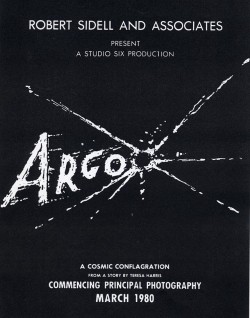
“Iran is planning to retaliate against Argo with its own big-budget movie, titled Joint Command, about the 1979–80 events and the secret operation that led to the escape of six U.S. diplomatic personnel.”
— Iran’s government-run press agencies are very upset about that Argo movie winning the American Oscar, especially because that one American lady presented the award. It’s like Tehran doesn’t even know the Obamas are Muslims!
How To Fail At Journalism In Exotic Foreign Lands

Budapest had never been my favorite European capital, but a job in a foreign city is always better than a job wherever I happen to be living at the moment. This is why, on a balmy Southern California morning in February of 1996, I voluntarily carried my only possessions to Los Angeles International Airport’s Tom Bradley terminal the customary three hours prior to departure. The first two hours passed pleasantly at the airport lounge, where my friend Steve and I drank double Greyhounds served in pint glasses.
The Double Greyhound is just a lot of vodka with grapefruit juice to soften the blow. We had been drinking these regularly in El Segundo, the LAX-adjacent working-class town noted for its sewage treatment plants and oil refineries. El Segundo means “The Second,” and the name comes not from California’s Old Spanish past, but from Standard Oil, which built its second West Coast refinery on farmland between Santa Monica and Manhattan Beach. Steve lived in a battered apartment complex with abandoned cars in the parking lot and an unobstructed view of Los Angeles International Airport. The noise was astounding. Each takeoff and landing made the windows rattle as beer bottles and drinking glasses walked themselves off the countertop and shattered on the yellowed vinyl flooring. It was so close to the airport that I had moved in for a week or two before my flight to Hungary, just to make sure I didn’t miss the plane. The successful budget traveler always plans ahead.
“When’s your flight supposed to leave, anyway?” Steve’s face had become blotched with patches of bright red, an allergic reaction to the vodka.
“About an hour,” I said, consulting my mail-order diver’s watch that I had actually purchased from an ad in the back of Parade magazine. My computer, paperbacks, magazines and toothbrush were in a black fake-leather laptop case. Everything else I owned was in a blue canvas duffel bag. We headed for my airline’s counter and found it mysteriously closed for the day. This should have been appreciated as an omen, but a nervous interlude resolved peacefully when I was transferred to a Lufthansa flight that would end up landing in Budapest only an hour later than originally planned, due to some kind of layover witchcraft.
“Considering I’ve got another couple of hours, I could really use a haircut,” I said.
Steve nodded gravely. “There’s a barber shop next to that bar in El Segundo. But then I really need to get to work.”
We eventually said good-bye at the gate — there was no security to speak of, in 1996 — and I settled into my economy seat, on my way to another newsroom on the other side of the planet. Steve went to his own newsroom, where he edited the entertainment section for a weekly beach town newspaper. (And by “edited,” I mean he wrote all the articles and headlines and did the layout. The community journalist is expected to wear many hats.) My plane was half empty and because it was a European carrier, smoking was still allowed aboard the jet. And I still smoked, so I enjoyed one cigarette’s worth of impossible luxury and freedom before stretching over an entire row of seats and settling into a deep vodka sleep that would last halfway around the globe.
***
Hungary was gray and cold, because it was wintertime and I had just voluntarily left the coast of Southern California for Central Europe. Cellphones were still rare and email a novelty. I wandered the dingy halls of the Budapest airport wondering if my friends knew my flight was late and also a completely different flight on another airline. And then I spotted a tall, lanky and very pale vampire of sorts with Nick Cave hair, waving and smiling at me. The American friends who got me hired for this job at an English-language business paper in Budapest had brought him along to the airport, so I worked through the crowd of Magyars and greeted these people who now held the reins of my existence.
The vampire was a refugee from the troubles in Kosovo and Serbia, stuck here in Hungary because the Austrians wouldn’t let him across the border. He was wildly enthusiastic about everything and had at least a dozen scams in the works, including benefit concerts for displaced Yugoslavs and a local Star Trek convention that would somehow get him dates with the six-foot-tall local women.
Samet, the Turkish-Albanian variation of the Islamic name Samed, was bunking at a youth hostel overrun with young people lacking the right visa to get somewhere else. He was also nearly broke and couldn’t legally get work in Hungary, so on the occasion of my Welcome To Town party, he was invited to join the three Americans in a dusty high-ceilinged apartment on Bartok Bela. Samet cleared out a monk-like cell where decades of broken furniture had been stuffed along with the unwanted heirlooms of whatever family owned this flat. I took a sofa in the immense main room with its three different living room sets. That was fine; I was always the last person awake.
Budapest was still an inexpensive city for an American, especially if that American had just collected various windfalls from unused vacation time, writing a couple of freelance chapters for one of those “For Dummies” computer books, and somehow selling two “story treatments” (single pages of occult nonsense) for a cable-TV revival of an old science-fiction anthology series “The Outer Limits.” I had something like four-thousand dollars in American Express travelers checks, enough to last at least a year if I didn’t go overboard with food and drink.
Eventually, after a lengthy round of parties and dinners and late nights of guitars and conversation, I had to report to my new job: technology columnist for the Budapest Business Journal. I knew little about the technology business and less about Hungary, but I was handy with “the Internet,” which was still baffling to newspaper people. (The technology seemed to come naturally to the young Hungarians working for the paper, and they would help make Budapest the 21st Century offshore IT capital of many U.S. new media businesses, including Gawker Media.) The office was on the second floor of a courtyard building a couple of tram stops from my apartment. It looked almost exactly like the computer-magazine office I’d just left in San Diego. My heart sank.
“We’ll probably put you here,” the managing editor said, pointing to somebody else’s portion of a work table crowded with press releases and copies of the Financial Times. He looked around to see if anyone would take care of this task, but everyone was either yelling in Hungarian on the phones or gazing intently at their monitors. The managing editor shrugged and got his overcoat. “I guess it’s time for lunch, anyway. Plus, you need to see the Chain Bar.”
The Chain Bar was a nearby lounge full of stout blue-collar workers in matching overalls and giant blonde prostitutes, a classic Disney scene of sorts. The jukebox played the theme from “The Rockford Files,” again and again. I missed my first, second and third Hungarian Lessons paid for by the newspaper before the receptionist stopped putting my name on the schedule. I excused this irresponsibility by remembering how hard I’d worked on Slovak a few years prior, and how I had yet to come across a need for knowing so much as a single word of the Slovakian tongue since leaving Bratislava. But the truth was and remains that I cannot learn foreign languages. For all the words and phrases I’ve collected, I have never surpassed the linguistic accomplishments of ordering dinner or figuring out the gist of a newspaper story (by looking at the picture).
Samet was a polyglot. No, he was a hyperpolyglot, fluent in English, Macedonian, Albanian, Turkish, German and both the Serbian and Croat variations of Serbo-Croatian. I believe he had learned classical Arabic from studying the Qur’an, and he apparently spoke nearly flawless Hungarian thanks to his few months stranded in the country. I needed to get out and report on things, because offices depress me, and Samet needed something to do with his time. We became a team, with my pay from the newspaper covering our rent and groceries at the apartment, and we covered trade shows.
***
There was a convention or technology fair every few days — technology was booming! — and these spectacles were just foreign enough to provide some material to potentially amuse MBAs from Chicago on the make in post-communist Central Europe. Urban Hungarians maintain a pagan appreciation of pure sexuality that has never been comfortable for most Americans. While barely dressed young women were commonly employed to sell video games at U.S. electronics shows, it would never occur to use astoundingly tall women in nothing but translucent panties and bras to sell accounting software. In Budapest, that was the norm. It was also common to find the bored models humping on their short, muscular boyfriends during lapses in business, under the cold fluorescent lights of whatever Trade Progress Hall, right next to the folding table with the branded ballpoint pens and logo stickers. Somewhere I still have a promotional mousepad handed to me by a model working an elaborate Microsoft booth: It was just a pornographic “double penetration” photograph with no conceptual ties to the local version of Excel that I could discern.
I can only assume that in the fifteen years since, the Hungarian technology sector has adopted the more prudish tech marketing habits of its international peers. It was pretty thin gruel for a weekly column, anyway, and during our long rides by taxi and tram to various industrial sectors and convention centers, Samet regaled me with tales of his hometown: Skopje, the charming capital of the new Macedonia and the only Yugoslav republic to reach independence without warfare. It was a land of opportunity. We could launch a radio station, a television station, even a feature-film production house. And so we decided to start all three, with my depleted packet of travelers checks as capital and Samet’s family home in Skopje as headquarters for this media empire.
It was already spring down there, 600 miles south on the green banks of the Vardar River, and we just needed to get through Serbia and Kosovo, which were just then beginning a war of their own. The Serbian military patrolling the trains would likely be unfriendly to an ethnic Albanian and an American traveling together without papers, but at least all the beer in our luggage was for me — Samet followed the Prophet’s ban on booze.
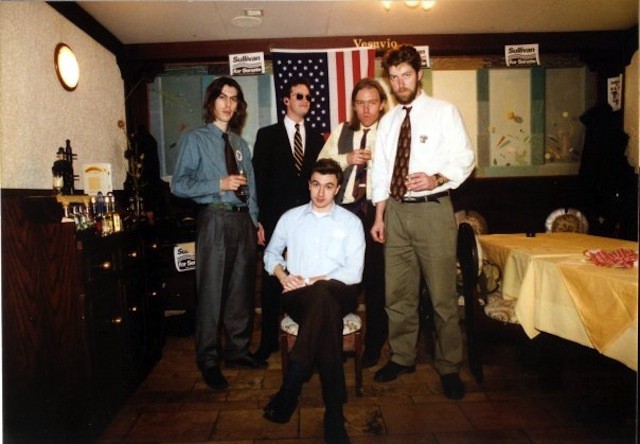
Samet, left, and the author, right, on the occasion of their colleague’s birthday and U.S. Senate campaign kickoff in Budapest. Photo by a waitress at Pinocchio’s Italian restaurant Jim Lowney.
Related: Life After Patch.com: A Newspaper Editor Returns To Newsprint
Ken Layne has held approximately a hundred media jobs around the world. He should’ve learned by now.
Top photo by Deannecow.
Mercedes Appeared in 30% of Top 2012 Movies

That is a pretty remarkable thing: From propaganda vehicle Act of Valor to propaganda vehicle Argo, Mercedes product placement dominated the 34 number-one box office flicks of last year, appearing in ten of them. (The big winner last year was Apple, with appearances in 42% of #1 films.) Don’t you want to drive a Mercedes now. And drink human blood. What will become of our children. When we are all pressed into service of the brands and industrial entertainment war complex. They will fight each other in the streets and then get into their Mercedes car-robots and zoom away to their abandoned buildings. So sad.
Turn On The Dark
Would turning down office and building lights in the city during the evening actually make streets safer? Sure, why the hell not.
Are You A Slave To Your CMS?

“The headline is finding relevance far beyond news media as it becomes a key weapon in fields like politics and business. No longer the exclusive province of copy editors, it is now the cornerstone of emailed political appeals, the fulcrum of crowdsourcing capital on Kickstarter, and arguably the basis of an entire communications medium, the all-headlines microblogging system Twitter…. New York-based Upworthy is part of a gamble by founders from Facebook, Reddit, and BuzzFeed that headlines can advance political change and profits at the same time. The aggregator, whose seed round closed this past October, makes editors write at least 25 different headlines for each post, then plugs top contenders into alternate versions of of its Facebook page and website to test which one elicits the maximum reaction.”
— Guess what sucks now? STUPIDITY, THAT’S WHAT.
